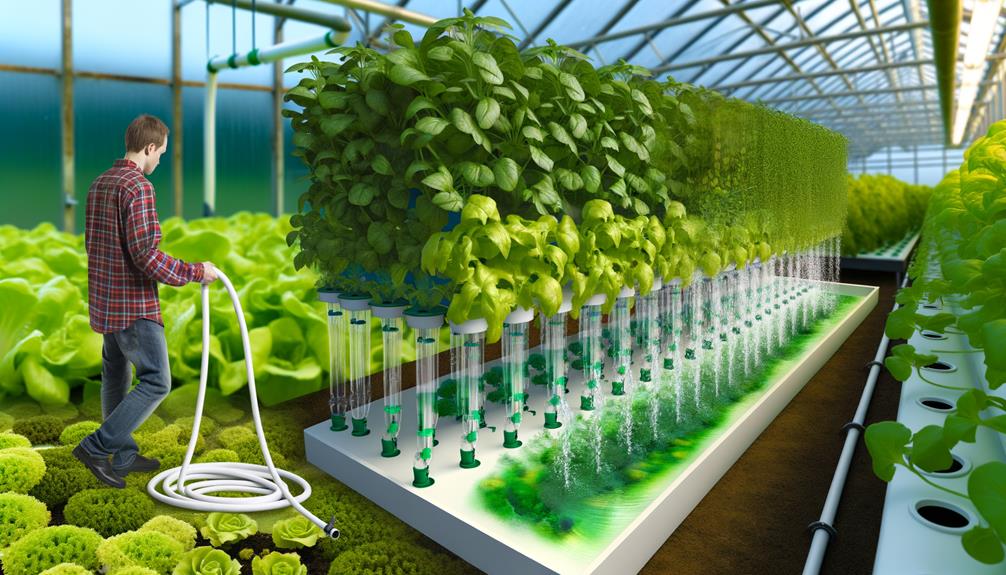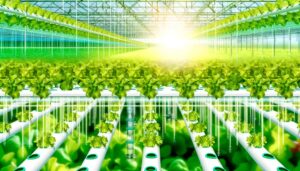Is a Hydroponic Garden Worth It
A hydroponic garden can be a worthwhile investment, particularly for those seeking efficient and resource-conserving plant cultivation. This method uses nutrient-rich water solutions, promoting faster growth rates and higher yields compared to soil farming.
Despite higher initial costs for equipment such as grow lights and nutrient solutions, hydroponics provides space efficiency and significant water conservation, using up to 90% less water. Additionally, its controlled environment reduces the risk of soil-borne pests and diseases.
Regular maintenance is essential to guarantee ideal nutrient balance and pH levels. For those aiming to maximize plant productivity and sustainability, further insights will be beneficial.

Key Takeaways
- Hydroponics offers up to 90% water savings compared to traditional soil farming.
- Initial setup costs for hydroponics can be high but provide long-term efficiency and higher yields.
- Hydroponic systems enable faster plant growth, maturing up to 50% quicker than soil-grown plants.
- Controlled environments in hydroponics significantly reduce the risks of pests and soil-borne diseases.
Understanding Hydroponics

Hydroponics, a method of growing plants without soil, utilizes nutrient-rich water solutions to deliver essential minerals directly to plant roots. This innovative approach circumvents traditional soil-based cultivation, offering enhanced control over nutrient uptake and pH levels, which can be refined for specific plant species.
Advanced hydroponic systems, such as nutrient film technique (NFT), deep water culture (DWC), and aeroponics, employ sophisticated methodologies to guarantee ideal oxygenation and hydration.
Research indicates that hydroponics can lead to accelerated growth rates and higher yields compared to traditional soil farming. In addition, this method reduces the risk of soil-borne diseases and pests, promoting healthier plant development.
These advantages render hydroponic systems particularly appealing for urban agriculture and controlled environment agriculture (CEA) applications.
Initial Investment Costs
Evaluating the initial investment costs for a hydroponic garden involves a thorough analysis of required equipment and supplies, including grow lights, nutrient solutions, and growth media.
Additionally, ongoing maintenance expenses such as electricity and nutrient replenishment must be factored into the overall cost assessment.
However, potential savings benefits, including reduced water usage and faster plant growth cycles, may offset these initial expenditures.
Equipment and Supplies Needed
Investing in a hydroponic garden necessitates a thorough understanding of the essential equipment and supplies, which include grow lights, nutrient solutions, pH meters, and specialized growing mediums. Utilizing high-intensity discharge (HID) lights or LED grow lights guarantees ideal photosynthesis. Nutrient solutions, rich in macro and micronutrients, are vital for plant health. pH meters maintain the ideal pH balance, typically between 5.5 and 6.5. Specialized mediums like Rockwool and coco coir provide structural support and efficient water retention. The initial costs of these components can be significant but are fundamental for a thriving hydroponic system.
| Equipment | Function | Approximate Cost |
|---|---|---|
| Grow Lights | Facilitates photosynthesis | $100 – $500 |
| Nutrient Solutions | Provides essential nutrients | $20 – $50 per gallon |
| pH Meters | Guarantees ideal pH balance | $10 – $100 |
Ongoing Maintenance Expenses
The ongoing maintenance expenses for a hydroponic garden encompass the continual replenishment of nutrient solutions, electricity for grow lights and pumps, and periodic replacement of pH meters and growing mediums.
Nutrient solutions must be precisely balanced and frequently monitored to guarantee peak plant growth, necessitating regular purchases of high-quality fertilizers.
Electricity costs are significant due to the constant operation of artificial lighting and water circulation systems, especially in larger setups.
Over time, pH meters, integral for maintaining the delicate pH balance of the nutrient solution, may require calibration or replacement.
Additionally, growing mediums such as rock wool or coco coir degrade and need periodic renewal to sustain plant health.
These ongoing expenses are vital for maintaining a productive hydroponic system.
Potential Savings Benefits
Despite the initial investment costs, a hydroponic garden can offer long-term financial benefits by greatly reducing the need for pesticides, herbicides, and traditional soil amendments.
Research indicates that hydroponic systems optimize nutrient delivery, enhancing plant growth efficiency. Additionally, hydroponic gardens utilize water more efficiently, conserving a significant resource.
Key financial benefits include:
- Reduction in chemical expenses: No need for pesticides or herbicides.
- Decreased water usage: Hydroponic systems use up to 90% less water than soil gardening.
- Lower fertilizer costs: Targeted nutrient delivery reduces overall fertilizer use.
- Space efficiency: Vertical farming methods increase yield per square foot.
Space Efficiency

Maximizing the utilization of available space, hydroponic gardening systems employ vertical stacking and compact setups to achieve high-density plant growth in limited areas.
This spatial efficiency is achieved through the implementation of aeroponic towers, nutrient film technique (NFT) channels, and deep water culture (DWC) basins, which facilitate the cultivation of multiple plant layers within confined environments.
Research indicates that hydroponic systems can produce up to 4-6 times the yield per square foot compared to traditional soil-based agriculture.
The integration of LED grow lights and automated nutrient delivery systems further optimizes space utilization by ensuring uniform light distribution and precise nutrient management.
This innovative approach renders hydroponics particularly advantageous for urban agriculture and small-scale indoor farming.
Growth Speed and Yield
Hydroponic systems have been shown to markedly accelerate plant growth rates due to optimized nutrient delivery directly to the root zone, bypassing soil-mediated nutrient uptake limitations.
Research indicates that hydroponically grown crops can achieve up to 25% faster development cycles and yield up to 30% more produce compared to traditional soil methods.
Additionally, hydroponics guarantees efficient resource utilization, minimizing water and nutrient waste through recirculating systems.
Faster Plant Development
One of the most compelling advantages of hydroponic systems is their ability to greatly accelerate plant growth and increase yields through precise control of nutrients, water, and environmental conditions.
Scientific studies have demonstrated that hydroponically grown plants can mature up to 50% faster than their soil-grown counterparts. This rapid development is attributed to several key factors:
- Optimized nutrient delivery: Guarantees plants receive essential minerals directly to the root zone.
- Controlled environment: Allows for year-round cultivation, unaffected by seasonal changes.
- Efficient water usage: Reduces water stress and promotes continuous growth.
- Enhanced oxygenation: Facilitates root respiration and nutrient uptake.
These factors collectively contribute to a more efficient and productive growth cycle, aligning with innovative agricultural practices.
Higher Crop Production
By leveraging the precise control over nutrient delivery and environmental conditions, hydroponic systems greatly enhance crop yields and growth rates compared to traditional soil-based agriculture.
Research indicates that hydroponically grown plants can achieve up to 25% faster growth rates and produce 30% higher yields. This is due to optimized nutrient solutions, pH levels, and oxygenation, which facilitate maximum nutrient uptake.
Additionally, the absence of soil-borne diseases and pests further augments productivity. Controlled lighting, temperature, and humidity settings create an ideal growth microenvironment, ensuring year-round cultivation.
Studies have demonstrated that leafy greens, tomatoes, and herbs particularly benefit, showing significant increases in both biomass and harvest frequency.
Consequently, hydroponics exemplifies a leap forward in agricultural innovation, promising substantial gains in crop production.
Efficient Resource Use
Leveraging the significant advancements in crop production, hydroponic systems also demonstrate remarkable efficiency in resource utilization, enhancing growth speed and yield while minimizing water and nutrient waste. Research indicates that hydroponic methods can accelerate plant growth by up to 50% compared to traditional soil cultivation. This efficiency stems from ideal nutrient delivery and controlled environmental conditions.
Key advantages include:
- Water Conservation: Uses up to 90% less water than conventional farming.
- Nutrient Optimization: Precise nutrient management reduces waste and improves plant health.
- Space Efficiency: Vertical farming setups maximize space utilization.
- Pest and Disease Control: Controlled environments reduce the risk of infestations.
Such innovations make hydroponics an attractive model for sustainable agriculture.
Water Usage

Hydroponic systems can reduce water consumption by up to 90% compared to traditional soil-based agriculture, according to recent studies.
This significant reduction is achieved through the recirculation and precise delivery of nutrient solutions directly to plant roots, minimizing water loss due to evaporation and runoff. The closed-loop systems employed in hydroponics retain and reuse water, enhancing efficiency.
Furthermore, hydroponic setups utilize advanced monitoring technologies to regulate pH levels and nutrient concentrations, ensuring ideal growth conditions while conserving water. The strategic use of drip irrigation and misting techniques further enhances water utilization.
Fundamentally, hydroponics embodies a paradigm shift in sustainable agriculture, providing a viable solution to global water scarcity challenges while maintaining high crop yields.
Maintenance Requirements
While hydroponic systems offer remarkable water efficiency, they also demand meticulous maintenance to confirm peak performance and plant health. Regular monitoring and adjustments are critical for sustaining ideal growth conditions.
Key maintenance tasks include:
- Nutrient Solution Management: Regularly check and adjust pH and electrical conductivity (EC) levels to confirm nutrient availability.
- Water Quality Control: Use filtered or distilled water to prevent mineral build-up and contamination.
- System Cleanliness: Periodically clean reservoirs, tubing, and containers to prevent algae and biofilm formation.
- Pump and Aeration Checks: Confirm pumps and aerators are functioning correctly to maintain adequate oxygenation and water flow.
These practices are essential for a thriving hydroponic garden.
Pest and Disease Control

In hydroponic gardening, effective pest and disease control is essential to safeguard plant health and secure ideal yield. The controlled environment of hydroponic systems greatly reduces the incidence of soil-borne diseases and pests.
However, vigilance remains vital, as pathogens can still infiltrate through water, air, or human handling. Integrated Pest Management (IPM) strategies, including biological control agents such as predatory insects and microbial inoculants, are highly recommended.
Regular monitoring and early detection through techniques like spectral imaging and molecular diagnostics can preempt widespread infestations. Utilizing sterile tools and maintaining best environmental conditions, such as humidity and temperature, further mitigate risks.
Employing these advanced practices guarantees robust plant growth and aligns well with the innovative spirit of hydroponic gardening.
Nutrient Management
Effective nutrient management in hydroponic systems is paramount to ensuring ideal plant growth and maximizing yield, building upon the foundation of pest and disease control to create a balanced and thriving ecosystem.
Precise nutrient formulation and delivery are critical, as hydroponic plants rely entirely on aqueous solutions for essential macronutrients and micronutrients. Research indicates that optimal nutrient ratios can greatly enhance photosynthetic efficiency and biomass production.
Key factors in nutrient management include:
- Solution pH levels: Ensuring optimal pH for nutrient uptake.
- Electrical Conductivity (EC): Monitoring to maintain appropriate nutrient concentration.
- Nutrient solution temperature: Regulating to prevent root stress.
- Regular monitoring: Frequent testing for nutrient imbalances.
Environmental Impact

Hydroponic gardening frequently demonstrates a reduced environmental footprint compared to traditional soil-based agriculture, primarily due to its efficient water usage and minimized need for chemical pesticides.
Research indicates that hydroponic systems can reduce water consumption by up to 90%, leveraging closed-loop irrigation techniques that recycle water and nutrients.
In addition, hydroponics eliminates soil-borne diseases, reducing the dependency on chemical pesticides and herbicides.
This method also allows for precise control over nutrient delivery, enhancing plant growth and yield without excessive fertilizer runoff, which can cause eutrophication in natural water bodies.
As urbanization continues, hydroponic systems provide a sustainable solution, utilizing vertical farming technologies that maximize space and reduce the carbon footprint associated with transportation and land use.
Conclusion
Hydroponic gardening presents a viable alternative to traditional soil-based cultivation, akin to a well-tuned orchestra producing harmonious growth.
Despite higher initial investments, the method offers enhanced space efficiency, accelerated plant growth, and optimized water usage.
Reduced pest and disease incidences, coupled with precise nutrient management, further substantiate its effectiveness.
However, ongoing maintenance and environmental considerations must be addressed.
Overall, hydroponics demonstrates significant potential for sustainable, high-yield agricultural practices, meriting further exploration and adoption.






